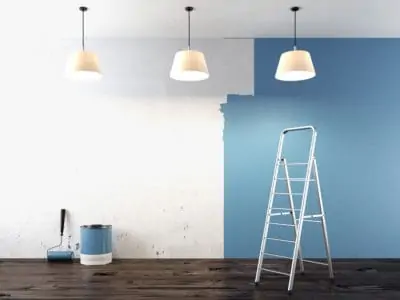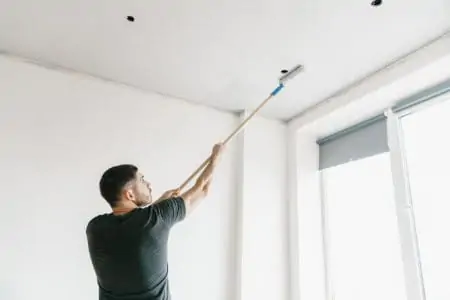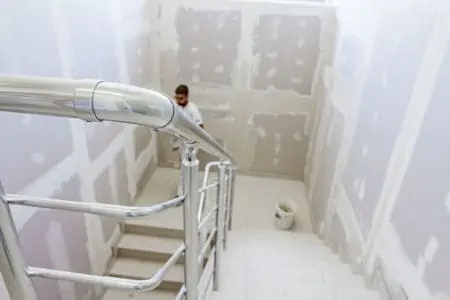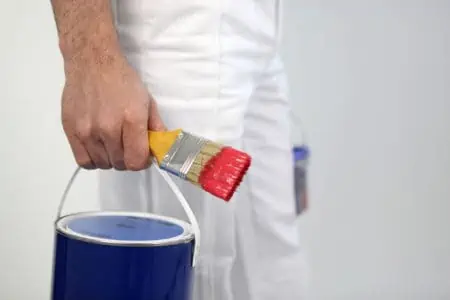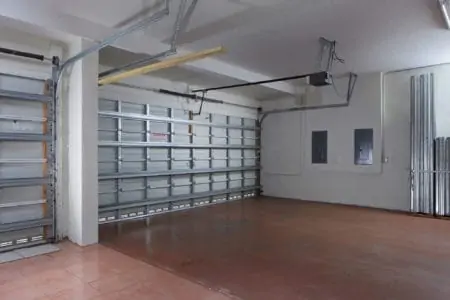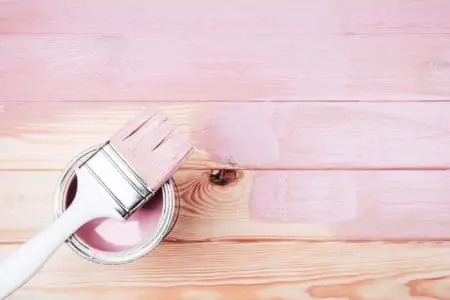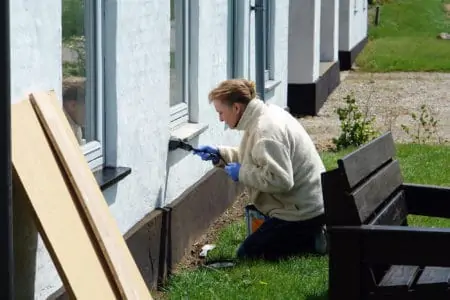Knowing the correct painting order is a classic catch 22 situation. You risk the paint splattering whichever way you do it. Don’t panic! There is a correct method to achieve a super smooth finish on your trim, that also delivers a professional finish for your walls.
We look at the benefits of knowing the right order to paint walls and trim and give you tips on getting a professional finish.
Key Takeaways
- Paint trim first for clean lines and easy coverage of splatters.
- Sand trim between coats to avoid sawdust on freshly painted walls.
- Experienced painters may choose to paint walls first for better control.
- Matte or satin paint is easier to cover over than gloss when painting walls first.
Is it Better to Paint Trim or Walls First?
Do you paint trim or walls first? It’s the question on most DIY enthusiasts’ lips. Knowing the correct order to start painting makes the task easier and gives you a better finish.
A lot comes down to the amount of preparation and your skill levels. A confident decorator will handle the brush or roller much more efficiently than a novice.
Should you Paint Trim First?
Painting the trim first gives you clean lines and immediate impact. It doesn’t matter if you get paint splatters onto the wall because you will be covering them up with fresh paint. Also, the decorator’s tape will protect the walls from the majority of spillages.
It is much easier to cover a lighter color with a dark one than the other way around.So if you are painting the trim a much darker color, it might be better to paint the walls first.
Another consideration when working on interior woodwork is that it will need sanding between coats to get a smooth finish. Painting your baseboards and window frames first avoids getting sawdust on the freshly painted walls.
Many DIY beginners prefer to tackle the trim first because it is the bit that takes the most concentration and skill. Once done, they can worry less about the walls and hope the decorator’s tape protects their handy work.
Also, if you are inexperienced at painting, you cannot afford to be as free with how you lay down the paint. You are more likely to make mistakes without clear lines to follow rather than free-handing the application. In experienced hands, the brush is better controlled.
Plus, because trim paints are mostly gloss or semi-gloss, it makes it harder to control the paint because they are thicker and take longer to dry.
When to Paint Walls First
Some people prefer to get the color down on the walls so that they can spend the final moments painting the intricate bits on the trim. An experienced decorator is more likely to dive right into painting the walls and worry about the trim later.
They will have a steadier hand and know how to cut in correctly for the cleanest lines. Also, a roller is great for faster wall coverage, but it also offers an excellent straight line when approaching corners and edges.
If the wall needs filling and sanding, it requires a lot of dirty preparation work. You wouldn’t want to get plaster dust on your freshly painted trims. If your walls need some TLC, it would be better to deal with that first and then lay down a layer of color before attempting the trim.
Depending on your experience level, it might be better to paint the trim first if the wall will be a darker color. Lighter paints may need several coats to cover darker pigments.
How to Paint Trim After Walls are Painted
So, the walls are covered in your preferred paint color, and now you need to get the trim done. Our technique makes the whole process a lot smoother and delivers professional-quality results, but first, we need to gather some tools.
What You’ll Need
- Roller cover.
- Roller frame and paint tray.
- 2-inch paintbrush.
- Drop cloths or 36-inch rosin paper.
- Decorator’s tape.
- Medium and fine-grade sandpaper.
- Brush or shop vac.
- Tack cloth.
- Caulk and caulk gun.
- Spackling paste.
- Goggles.
- Face mask.
1. Prep the Room
Clear out the room so you have access to all the woodwork without obstructions. If you have carpet, take the decorator’s tape and run a strip where the carpet meets the trim. This ensures the edge of the tape closest to the trim is tucked under the carpet.
This helps to create a clean separation line without getting paint on the carpet. Now grab your drop cloths or rosin paper and cover the floor. Rosin paper is better because it gives you protection without having to drag heavy drop cloths around the room.
If you have solid floors, run a strip of tape along the edge where the trim meets the floor.
You’ll need to run the tape along the edge of the door and window frame the same way as the floor. Ensuring that the line is as close and straight as possible. You can choose to remove the door altogether or run two strips of tape over the hinges to protect it from paint splatters.
Likewise, you should run a line of tape along the ceiling to protect it from paint splatters.
2. Clean the Trim
The amount of cleaning required depends on which space you are decorating. In a room like the kitchen, your trim will have a higher level of grease and grime buildup.
A mix of warm, soapy water applied with a sponge should be enough to tackle the average amount of dirt. Always wash away the soap residue and wait for the trim to dry.
3. Filling Gaps and Holes
Your trim needs to be as perfect as possible because gloss paint highlights every imperfection. Spending the time to prepare the wood surface will reap dividends later down the line. Spackling paste works really well when filling holes because it applies easily and is simple to sand smooth.
A Word Of Advice
Only use spackling paste on gaps and holes on the wooden surface. Don’t use it to fill in gaps between the wall and the trim.
Use caulk for these gaps. If you use spackling paste, it will crack and fall out, whereas caulk flexes. Once the spackling paste dries, it’s time to sand.
4. Sanding the Trim
Before You Start
Don your safety goggles and face mask to prevent sawdust from getting in your eyes and minimize the health risks associated with sawdust inhalation.
Sanding trim serves two purposes: it smooths the holes and gaps filled with spackling paste and ensures the entire frame is smooth for the new layer of paint. If the trim is already painted, rough it up so the fresh paint adheres.
If you don’t create a key first (this is a form of abrading to remove surface material), the new paint and primer will not stick properly and flake prematurely.
Use medium-grit sandpaper to remove imperfections and smooth the surface of the trim. The whole process should take between 10 and 15 minutes. Now, grab the shop vac and remove the sawdust. You can use a tack cloth on the finest dust particles.
5. Time to Prime
Once you are satisfied the trim is prepared, it’s time to break out the primer. The type of primer depends on the topcoat you have chosen. If you are glossing the trim, the paint is likely oil-based, so use an oil-based primer.
When painting with water-based topcoats, you should always use a water-based primer. Water-based paints are recommended for interior surfaces because they are low in odor and VOCs (volatile organic compounds), which release low-level ozone as it dries.
Water-based products are also easier to clean up than oil-based paints because you only need soapy water rather than thinners or mineral spirits.
If you are working indoors with oil-based paint, make sure you open doors and windows to get the best ventilation.
For exterior trim, oil-based paints are better because they are resistant to the elements and UV radiation. When painting with primer, try to use long strokes that run the length of the trim. The smoother you apply the primer, the better it adheres, seals, and covers evenly.
Once the first coat of primer has dried, you will need the fine-grade sandpaper to smooth between layers. Don’t apply too much pressure or you risk taking off the fresh paint. You only want to clean up imperfections and small drips that you might get.
Grab the shop vac and clean away the sawdust before laying down a second primer coat.
6. Time to Caulk
Caulking gaps along the edge of your trim where it meets the wall will give you a straight edge and hide any large holes that show up against your white paint.
You can caulk before sanding or do it after you have primed the trim. There are no discernable benefits of doing it before you paint the primer. Caulk is paintable, so if you want the thinnest line possible, it might be better to prime first.
Cut a small piece off the caulk tip at a 45-degree angle to make it easier to run the caulk along the trim line. Work in 10-inch strips before releasing the pressure on the caulk gun trigger. Then, use a wet cloth or the tip of your finger to smooth the caulk into a neat line. Allow time for the caulk to dry before painting.
Top Tip
Start caulking in the corners to get the smoothest finish.
7. Painting the First Topcoat
Now that all the prep work is done and you have two layers of dried primer, it’s time to paint the first topcoat. Using the paintbrush, apply the paint in long and steady strokes to ensure you get enough paint on without drips or runs.
Once the first coat has dried, grab the fine-grade sandpaper and remove any blemishes and imperfections. This final round of sanding ensures a super smooth finish.
Use the shop vac to remove any sawdust before you are ready for the final topcoat. You can also use a tack cloth for the finer particles of dust.
8. Painting the Final Topcoat
Use the same long steady strokes as when you applied the first layer of topcoat. Ensure the brush is loaded with just enough paint to get even coverage without drips or runs. The final layer needs less paint than the first coat, so it should paint on more easily.
This is because you have created a non-porous base layer of primer and topcoat, so the paint will not absorb deep into the woodwork.
9. Cleanup Time
Once the second layer of topcoat has dried but not cured, peel away the decorator’s tape. Work slowly as you pull the tape away from the edge of the paint to ensure that you don’t spoil the neat lines.
To clean your brushes, use the correct cleaning agent for the type of paint used, so thinner for oil-based products and soapy water for water-based paints.
Tips for Painting Clean Lines Like a Pro
Painting is an art form, and the pros spend years perfecting their craft, so it is no surprise that they have some top tips for getting that perfectly straight line. It also makes life easier knowing some techniques will save you time and stress.
Use a Roller for Edges
Paint rollers have a straight edge, making it easier to get that neat line. With a steady hand, you can get close to trim edges without splattering paint everywhere. Rollers are also easier to control compared to brushes, and they distribute the color more evenly.
Use a 3-inch roller to get tight into edges, and then finish off the line with a 2-inch brush.
Score Along the Tape
When the paint dries, it forms a hard film, joining the walls and decorator’s tape. When you pull the tape, you risk peeling off chunks of dried paint from the walls.
Grab a sharp knife and score along the edge of the tape to break the paint film, so the tape peels more easily without taking off paint from the trim or walls.
Use an Angled Brush
Angled brushes enable you to get a neater line because the bristles are angled to distribute the paint more evenly. As long as you don’t overload the brush and keep a steady hand, it should give you a professional finish.
Don’t Overload the Brush
If you put too much paint on the brush, you risk drips and splatters as the paint flows too quickly as it leaves the bristles. It also makes it tricky for the brush to distribute the color evenly, and you end up with too much paint on the wall or trim.
Use an Edger Tool
Edgers are excellent tools for a faster straight line when painting at 90-degree angles. Load the pad with paint and allow the small wheels of the edger to run along the surface as the color spreads in a straight line.
Use Decorator’s Tape
Taping off edges is time-consuming, but it is a great way to achieve straight lines. It adheres to almost any surface and is easy to peel away when the paint starts to dry.
Use a Smaller Brush
Although more time-consuming, a smaller brush might be the answer to getting straight lines. They are easier to control, hold less paint, and give you a better chance of getting right up to the edges.
Hold the Brush Correctly
Hold the brush with four fingers on the handle and the thumb resting against the base for a firm and controlled grip. It might feel strange at first because it isn’t the natural way to hold a brush, but it will improve your direction and control.
Use Quality Tape
Quality decorator’s tape holds together better, doesn’t disintegrate when it gets loaded with paint, and it doesn’t stretch when you stick it down. It also adheres to prevent the paint from seeping underneath.
Cheaper tape does all these things, which leaves you struggling to achieve straight lines. It’s also a pain to remove without it snapping off in small sections.
Use a Putty Knife
When applying the painter’s tape, use a putty knife to flatten out any air bubbles to ensure the tape has stuck to the surface and there won’t be any seepage. Air bubbles trap paint, reducing the sharpness of your lines, which will only show after the paint has dried and the tape is removed.
Use a Spirit Level
Spirit levels are the perfect tool for drawing straight lines on walls. Press the device against the surface where you want the line to be and line the bubble to the middle of the two lines indicated on the tool.
Now draw the line, and it will be perfectly straight, giving you an accurate guide for the brush or roller.
Keep a Wet Cloth Handy
Inevitably, you will get some paint splatters, so having a damp cloth handy will save you messing up the lines. Wipe the paint off while still wet, ensuring that you only remove the rogue paint rather than the paint along the line.
FAQs
Walls or Trim First?
If you are a confident decorator and know how to handle a brush or roller, we will leave it to personal choice, but for novices, painting the trim first is easily the best route forward.
Whichever way you decide, don’t be afraid of making mistakes because that’s how we all learn.
